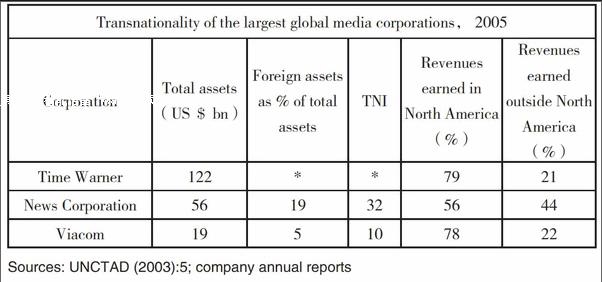Imperialism in Current Film Industry
李雯婷

Abstract:In current patterns of media, old media and new media both prevail in modern society. Since media is a too broad term, this article will focus on the film industry. It will state whether the imperialism of Hollywood, a typical media giant, exists in the film industry and its influence on cultural globalization.
Key words:film industry;imperialism;globalization
Before the discussion of imperialism in the current film industry, the meaning of media imperialism should be first defined. Chin-Chuan Lee(1980) describes media imperialism of television culture in his book: “Specifically, media imperialism refers to television program exportation to foreign countries; foreign ownership and control of media outlets; transfer of the ‘metropolitan broadcasting norms and institutionalization of media commercialism at the expense of ‘public interest; and invasion of capitalistic world views and infringe upon the indigenous way of life in the recipient nation.” (Lee, 1980: 68) To sum up, there are four features in the meaning of media imperialism.
In my view, media industries have moved from imperialism to globalization. Nowadays, the logic of accumulation of media industry has changed. Local media industries begin to show their powers. For example, Asian media industries become more globalized, by having adapted many marketing strategies learned from foreign competitors. Consequently, the film companies have to change their strategies. ‘As applied to contemporary media, this insight suggests that even though a film or TV company may be founded with the aim of serving a particular national culture or a local market, over time it must redeploy its creative resources and reshape its terrain of operations if it is to survive competition and enhance profitability (Holt and Perren, 2009:112). At first, Hollywood was dependent on small, collaborative labors for filmmaking. But due to the development of theater chain, complicated distribution and severe competition, it began to rely on creative labors. ‘As American cinema entered this factory phase during the 1910s, the intensification of production accelerated output and yielded cost efficiencies, providing theater operators around the country with a dependable flow of quantity products (Bordwell et al., 1985).
Trajectories of creative migration are the second principal of the media industry. Screen producers should face a big challenge that is attracting and managing talents. Before modern times,the authorities kept the artists in a certain place for their work. But now, industrialists build performance places to attract the talents to commercial cities. Film industries would recruit some talents from popular theater or cultivate new talents. Meanwhile, the artists would no longer be the long-term ones. Hollywood, however, is still the dream of many cultural labors.Workers stay around Hollywood since it provides workers with lots of employment chances.endprint

